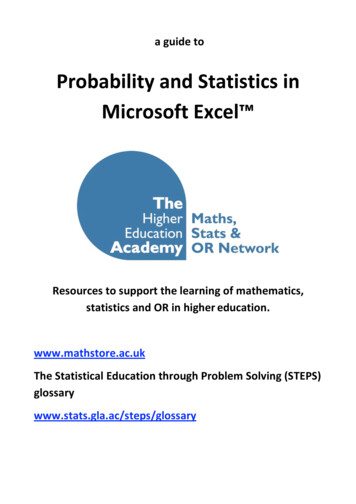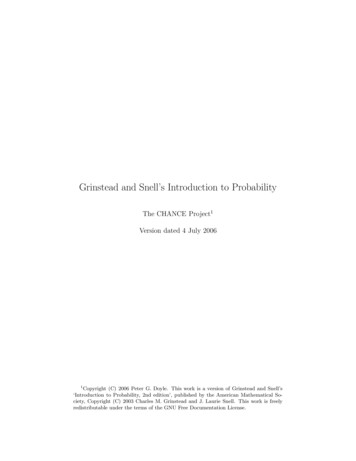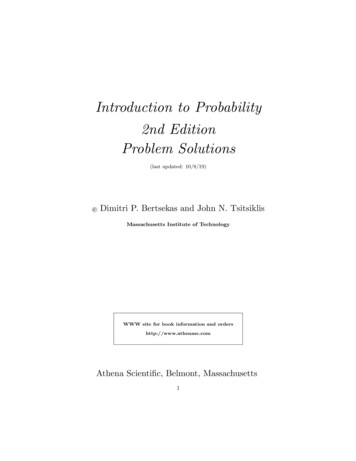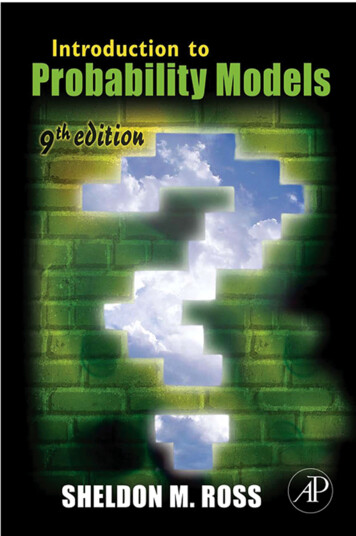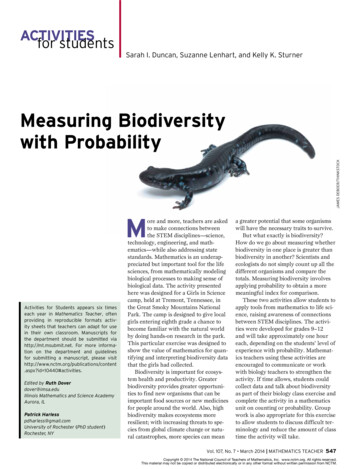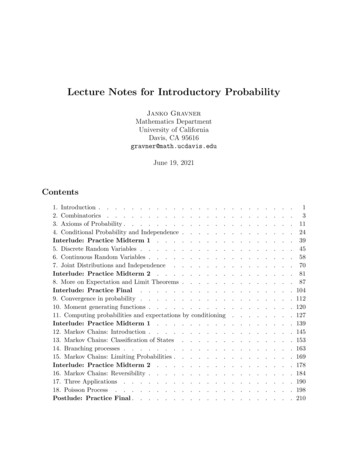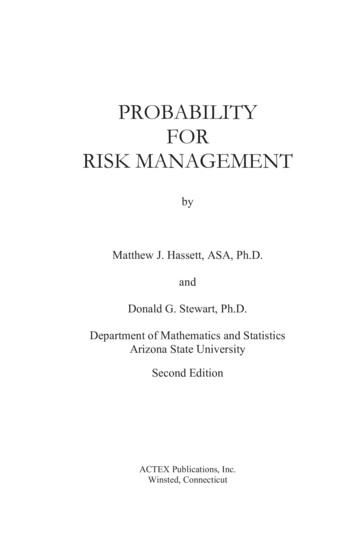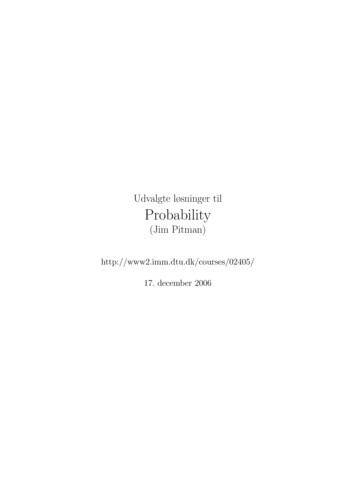
Transcription
Udvalgte løsninger tilProbability(Jim Pitman)http://www2.imm.dtu.dk/courses/02405/17. december 2006
102405 Probability2004-2-2BFN/bfnIMM - DTUSolution for exercise 1.1.1 in PitmanQuestion a)23Question b) 67%.Question c) 0.667Question a.2)47Question b.2) 57%.Question c.2) 0.571
102405 Probability2004-2-2BFN/bfnIMM - DTUSolution for exercise 1.1.2 in PitmanQuestion a) 8 of 11 words has four or more letters:Question b) 4 words have two or more vowels:Question c) The same words qualify (4):411411811
102405 Probability2003-9-10BFN/bfnIMM - DTUSolution for exercise 1.2.4 in PitmanIt may be useful to read the definition of Odds and payoff odds in Pitman pp. 6 inorder to solve this exerciseQuestion a) We define the profit prpr 10(8 1) 100 · 1 10Question b) The average gain pr. game is defined as the profit divided by the numberof games 10pr 0.1n100
1IMM - DTU02405 Probability2004-2-4BFN/bfnSolution for exercise 1.3.1 in PitmanDenote the fraction the neighbor gets by x. Then your friend gets 2x and you get 4x.The total is one, thus x 71 and you get 74 .
102405 Probability2004-9-3BFN/bfnIMM - DTUSolution for exercise 1.3.2 in PitmanQuestion a) The event which occurs if exactly one of the events A and B occurs(A B c ) (Ac B)Question b) The event which occurs if none of the events A, B, or C occurs.(Ac B c C c )Question c) The events obtained by replacing “none” in the previous question by“exactly one”, “exactly two”, and “three”Exactly one (A B c C c ) (Ac B C c ) (Ac B c C)Exactly two (A B C c ) (A B c C) (Ac B C)Exactly three (A B C)
1IMM - DTUSolution for exercise 1.3.4 in PitmanWe define the outcome space Ω {0, 1, 2}Question a) yes, {0, 1}Question b) yes, {1}Question c) no, (we have no information on the sequence)Question d) yes, {1, 2}02405 Probability2004-2-4KKA,BFN/bfn,kka
102405 Probability2003-9-13KKA/bfn,kkaIMM - DTUSolution for exercise 1.3.8 in PitmanIt may be useful to make a sketch similar to the one given at page 22 in Pitman.From the text the following probabilities are given:P (A) 0.6 P (Ac ) 1 P (A) 0.4P (B) 0.4 P (B c ) 1 P (B) 0.6P (AB) P (A B) 0.2Question a)P (A B) P (A) P (B) P (AB) 0.6 0.4 0.2 0.8Question b)P (Ac ) 1 P (A) 1 0.6 0.4Question c)P (B c ) 1 P (B) 1 0.4 0.6Question d)P (Ac B) P (B) P (AB) 0.4 0.2 0.2Question e)P (A B c ) 1 P (B) P (AB) 1 0.4 0.2 0.8Question f )P (Ac B c ) 1 P (A) P (B) P (AB) 1 0.6 0.4 0.2 0.2
102405 Probability2003-9-18BFN/bfnIMM - DTUSolution for exercise 1.3.9 in PitmanQuestion a)P (F G) P (F ) P (G) P (F G) 0.7 0.6 0.4 0.9using exclusion-inclusion.Question b)P (F G H) P (F ) P (G) P (H) P (F G) P (F H) P (G H) P (F G H) 0.7 0.6 0.5 0.4 0.3 0.2 0.1 1.0using the general version of exclusion-inclusion (see exercise 1.3.11 and 1.3.12).Question c)P (F c Gc H) P ((F G)c H)P (H) P ((F G)c H) P ((F G) H)The latter probability isP ((F G) H) P ((F H) (G H)) P (F H) P (G H) P (F G H) 0.3 0.2 0.1 0.4such thatP (F c Gc H) 0.5 0.4 0.1
102405 Probability2003-9-11BFN/bfnIMM - DTUSolution for exercise 1.3.11 in PitmanP (A B C) P (A (B C))now applying inclusion-exclusionP (A (B C)) P (A) P (B C) P (A (B C)) P (A) P (B C) P ((A B) (A C))once again we aplly inclusion-exclusion (the second and the third time) to getP (A (B C)) P (A) P (B) P (C) P (B C) (P (A B) P (A C) P ((A B) (A C))) P (A) P (B) P (C) P (B C) P (A B) P (A C) P (A B C)
102405 Probability2003-9-11BFN/bfnIMM - DTUSolution for exercise 1.3.12 in PitmanWe know from exercise 1.3.11 that the formula is valid for n 3 and consider nP n 1i 1 Ai P (( i 1 Ai ) An 1 ) .Using exclusion-inclusion for two events we get the formula stated p.32. Since theexclusion-inclusion formula is assumed valid for n events we can use this formula forthe first term. To get through we realize that the last termP ( ni 1 Ai An 1 )is of the formP ( ni 1 Bi )with Bi Ai An 1 , implying that we can use the inclusion-exclusion formula for thisterm too. The proof is completed by writing down the expansion explicitly.
102405 Probability2004-2-4BFN/bfnIMM - DTUSolution for exercise 1.4.1 in PitmanQuestion a) Can’t be decided we need to know the proportions of women and men(related to the averaging of conditional probabilities p. 41)Question b) True, deduced from the rule of averaged conditional probabilitiesQuestion c) TrueQuestion d) TrueQuestion e)true31· 0.92 · 0.88 0.9144
102405 Probability2003-9-13KKA/bfn,kkaIMM - DTUSolution for exercise 1.4.2 in PitmanWe define the eventsA The light bulb is not defectB The light bulb is produced in city BFrom the text the following probabilities are given:P (A B) 0.99 P (Ac B) 1 P (A B) 0.01P (B) 1/3 P (B c ) 2/3solutionP (A B) P (B)P (A B) 0.99/3 0.33
1IMM - DTU02405 Probability2003-9-24BFN/bfnSolution for exercise 1.4.9 in Pitman1) of beingQuestion a) In scheme A all 1000 students have the same probability ( 1000chosen. In scheme B the probability of being chosen depends on the school. A1, from the secondstudent from the first school will be chosen with probability 30011with probability 1200 , and from the third with probability 1500 . The probability11of chosing a student from school 1 is p1 · 100, thus p1 10. Similarly we find12p2 5 and p3 2 .
102405 Probability2003-9-11BFN/bfnIMM - DTUSolution for exercise 1.5.3 in PitmanC The event that the chip is okA The event that a chip is accepted by the cheap testQuestion a)P (C A) P (A C)P (C)1 · 0.8 P (A C)P (C) P (A C c )P (C)c0.8 0.1 · 0.2Question b) We introduce the eventS Chip soldP (S) 0.8 0.2 · 0.1 0.82The probability in question isP (C c S) P (S C c )P (C c )0.1 · 0.21 P (S C c )P (C c ) P (S C)P (C)0.02 1 · 0.841
102405 Probability2003-9-13BFN/bfnIMM - DTUSolution for exercise 1.5.5 in PitmanDefine the eventsH A randomly selected person is healthyD A randomly selected person is diagnosed with the diseaseQuestion a) From the text we have the following quantitiesP (H) 0.99P (D H) 0.05P (D H c ) 0.8and from the law of averaged conditional probabilities we getP (D) P (H)P (D H) P (H c )P (D H c ) 0.99 · 0.05 0.01 · 0.8 0.0575Question b) The proability in questionP (H c Dc ) P (H c )P (Dc H c ) 0.01 0.2 0.002using the multiplication (chain) ruleQuestion c) The proability in questionP (H Dc ) P (H)P (D c H) 0.99 0.95 0.9405using the multiplication (chain) ruleQuestion d) The probability in question is P (H c D). We use Bayes rule to “interchange” the conditioningP (H c D) P (D H c )P (H c ) 0.8 · 0.010.008 0.05 · 0.99 0.139P (D H c )P (H c ) P (D H)P (H)Question e) The probabilities are estimated as the percentage of a large group ofpeople, which is indeed the frequency interpretation.
102405 Probability2004-2-10BFN/bfnIMM - DTUSolution for exercise 1.5.9 in PitmanDenote the event that a shape of type i is picked by Ti , the event that it lands flat byF and the event that the number rolled is six by S. We have P (T i ) 31 , i 1, 2, 3,P (F T1 ) 13 , P (F T2 ) 12 , and P (F T3 ) 32 P (S F ) 21 , and P (S F c ) 0.Question a) We first note that the six events Ti F and Ti F c (i 1, 2, 3) is apartition of the outcome space. Now using The Rule of Averaged ConditionalProbabilities (The Law of Total Probability) page 41P (S) P (S T1 F )P (T1 F ) P (S T2 F )P (T2 F ) P (S T3 F )P (T3 F ) P (S T1 F c )P (T1 F c ) PThe last three terms are zero. We apply The Multiplication Rule for the probabilities P (Ti F ) leading toP (S) P (S T1 F )P (F T1 )P (T1 ) P (S T2 F )P (F T2 )P (T2 ) P (S T3 F )P (F T3 )P (T3 )a special case of The Multiplication Rule for n Events page 56. Inserting numbersP (S) 1111 111 121 233 223 2334Question b) The probability in question is P (T1 S). Applying Bayes’ rule page 49P (T1 S) P (S T1 )P (T1 ) P (S)116314 29
102405 Probability2004-2-7BFN/bfnIMM - DTUSolution for exercise 1.6.1 in PitmanThis is another version of the birthday problem. We denote the event that the first npersons are born under different signs, exactly as in example 5 page 62. Correspondingly, Rn denotes the event that the n’th person is the first person born under the samesign as one of the previous n 1 persons. We findP (Dn ) n Yi 1i 11 12We find P (D4 ) 0.57 and P (D5 ) 0.38. ,n 13
102405 Probability2003-9-24BFN/bfnIMM - DTUSolution for exercise 1.6.5 in PitmanQuestion a) We will calculate the complementary probability, the no student has thesame birthday and do this sequentially. The probability that the first student has364, the same is true for all the remaining n 2 students.a different birthday is 365The probability in question is n 1364P (All other n 1 students has a different birthday than no.1) 1 365Question b)1 364365 n 1 ln (2)1 n 1 253.72ln (365) ln (364)Question c) In the birthday problem we only ask for two arbitrary birthdays to bethe same, while the question in this exercise is that at least one out of n 1 hasa certain birthday.
102405 Probability2003-9-18BFN/bfnIMM - DTUSolution for exercise 1.6.6 in PitmanQuestion a) By considering a sequence of throws we getP (1) 01P (2) 652P (3) 66543P (4) 6665434P (5) 666654325P (6) 6666654321P (7) 66666Question b) The sum of the probabilities p2 to p6 must be one, thus the sum inquestion is 1.Question c) Can be seen immediately.
1IMM - DTU02405 Probability2004-9-24BFN/bfnSolution for exercise 1.6.7 in PitmanQuestion a) The exercise is closely related to example 7 p.68. Using the same notation and approachP (Current flows) P ((S1 S2 ) S3 ) (1 P (S1c S2c ))P (S3 ) (1 q1 q2 )q3(use 1 p1 p2 q1 p2 p1 q2 q1 q2 to get the result in Pitman)Question b)P (Current flows) P (((S1 S2 ) S3 )cupS4 ) 1 (1 q1 q2 )q3 q4(or use exclusion/inclusion like Pitman)
102405 Probability2003-9-13BFN/bfnIMM - DTUSolution for exercise 1.6.8 in Pitmanquestion a) The events Bij occur with probabilityP (Bij ) 1365It is immediately clear thatP (B12 B23 ) 1 P (B12 )P (B23 ).3652implying independence. The following is a formal and lengthy argument. DefineAij as the the event that the i’th person is born the j’th day of the year.1We have P (Aij ) 365and that A1i , A2,j , A3,k , and A4,l are independent. Theevent Bij can be expressed byBij 365k 1 (Ai,k Aj,k )1by the independence of Ai,k and Aj,k . The event B12 B23such that P (Bij ) 365can be expressed byB12 B23 365k 1 (A1,k A2,k A3,k )and by the independence of the A’s we get P (B12 B23 ) question b) The probabilityP (B13 B12 B23 ) 1 6 P (B13 )thus, the events B12 , B13 , B23 are not independent.question c) Pairwise independence follows from a)13652
1IMM - DTU02405 Probability2004-2-10BFN/bfnSolution for exercise 2.1.1 in PitmanQuestion a) We use the formula for the number of combinations - appendix 1, page512 (the binomial coefficient) 7!7·6·577 35434!3!3·2·1Question b) The probability in question is given by the binomial distribution, see eg.page 81. 3 45135 · 12535 0.01566667
102405 Probability2003-9-13BFN/bfnIMM - DTUSolution for exercise 2.1.2 in PitmanWe define the events Gi: i girls in family. The probabilities P (Gi) is given by thebinomial distribution due to the assumptions that the probabilities that each child isa girl do not change with the number or sexes of previous children. i 4 1134 1 1P (Gi) ,P (G2) 6 · i 2 2168P (G2c ) 1 P (G2) 58
102405 Probability2004-2-10BFN/bfnIMM - DTUSolution for exercise 2.1.4 in PitmanWe denote the event that there are 3 sixes in 8 rolls by A, the event that there are 2sixes in the first 5 rolls by B. The probability in question is P (B A). Using the generalformula for conditional probabilities page 36P (B A) P (B A)P (A)The probability P (B A) P (A B)P (B) by the multiplication rule, thus as a speicalcase of Bayes Rule page 49 we getP (B A) P (A B)P (B)P (B A) P (A)P (A)Now the probability of P (A) is given by the binomial distribution page 81, as is P (B)and P (A B) (the latter is the probability of getting 1 six in 3 rolls). Finally 535 53 3 52212 65 1 63P (2 sixes in 5 rolls)P (1 six in 3 rolls) P (B A) P (3 sixes in 8 rolls)5 5582 683a hypergeometric probability. The result generalizes. If we have x successes in n trialsthen the probability of having y x successes in m n trials is given by mn myx y nxThe probabilities do not depend on p.
102405 Probability2005-5-30BFN/bfnIMM - DTUSolution for exercise 2.1.6 in PitmanWe define events Bi that the man hits the bull’s eye exactly i times. The probabilitiesof the events Bi is given by the Binomial distribution 80.7i0.38 iP (Bi) iQuestion a) The probability of the eventP (B4) 8·7·6·5 4 40.7 0.3 0.13614·3·2·1Question b)P (B4 8i 2 Bi ) P ((B4 ( 8i 2 Bi ))P (B4) 0.13638P ( i 2 Bi )1 P (B0) P (B1)Question c) 62 0.72 0.34 0.0595
102405 Probability2004-2-10BFN/bfnIMM - DTUSolution for exercise 2.2.1 in PitmanAll questions are answered by applying The Normal Approximation to theqBinomial Distribution page 99 (131). We have µ n · p 400 · 21 200, σ npq 400 21 12 10. The questions differ only in the choice of a and b in the formula.Question a) a 190, b 210P (190 to 210 successes) Φ 210.5 20010 Φ 189.5 20010 Φ(1.05) Φ( 1.05) 0.8531 (1 0.8531)0.7062Question b) a 210, b 220P (210 to 220 successes) Φ 220.5 20010 Φ 209.5 20010 Φ(2.05) Φ(0.95) 0.9798 0.8289 0.1509Question c) a 200, b 200P (200 successes) Φ 200.5 20010 Φ 199.5 20010 Φ(0.05) Φ( 0.05) 0.5199 (1 0.5199) 0.0398Question d) a 210, b 210P (210 successes) Φ
IMM - DTU 02405 Probability 2003-9-24 BFN/bfn Solution for exercise 1.4.9 in Pitman Question a) In scheme Aall 1000 students have the same probability (1 1000) of being chosen. In scheme Bthe probability of being chosen depends on the school. A student from the rst school will be chosen with probability 1 300, from the second with probability 1 .

